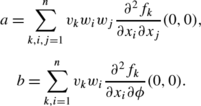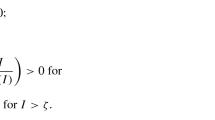Abstract
We consider an epidemic model for the dynamics of a vaccine-preventable disease, which incorporates the treatment and an imperfect vaccine given to susceptible individuals. We show that in spite of the simple structure of the model, a backward bifurcation may always occur if the treatment rate is above a threshold value. This occurs regardless of the specific form of the force of infection, which is only required to be infinitesimal of the same order of the size of the infectious compartment I, as I→0. This includes many commonly used functionals, as the linear, the monotone saturating Michaelis-Menten and the non-monotone force of infection used to represent the ‘psychological effect’.



Similar content being viewed by others
References
Alexander, M.E., Moghadas, S.M.: Bifurcation analysis of an SIRS epidemic model with generalized incidence. SIAM J. Appl. Math. 65, 1794–1816 (2005)
Anderson, R.M., May, R.M.: Infectious Diseases in Humans: Dynamics and Control. Oxford University Press, Oxford (1991)
Arino, J., McCluskey, C.C., van den Driessche, P.: Global results for an epidemic model with vaccination that exhibits backward bifurcation. SIAM J. Appl. Math. 64, 260–276 (2003)
Brauer, F.: Backward bifurcations in simple vaccination models. J. Math. Anal. Appl. 298, 418–431 (2004)
Brauer, F., van den Driessche, P., Wu, J. (eds.): Mathematical Epidemiology. Lecture Notes in Mathematics. Mathematical Biosciences Subseries, vol. 1945. Springer, Berlin, Heidelberg (2008)
Buonomo, B., Lacitignola, D.: On the dynamics of an SEIR epidemic model with a convex incidence rate. Ric. Mat. 57, 261–281 (2008)
Buonomo, B., Lacitignola, D.: On the backward bifurcation of a vaccination model with nonlinear incidence. Nonlinear Anal. Model. Control 16, 30–46 (2011)
Capasso, V.: Mathematical Structures of Epidemic Systems. Lecture Notes in Biomath., vol. 97. Springer, Berlin (1993)
Capasso, V., Serio, G.: A generalization of the Kermack-McKendrick deterministic epidemic model. Math. Biosci. 42, 41–61 (1978)
Castillo-Chavez, C., Song, B.: Dynamical models of tuberculosis and their applications. Math. Biosci. Eng. 1, 361–404 (2004)
Diekmann, O., Heesterbeek, J.A.P.: Mathematical Epidemiology of Infectious Diseases: Model Building, Analysis and Interpretation. Wiley, New York (1999)
Diekmann, O., Heesterbeek, J.A.P., Metz, J.A.J.: On the definition and the computation of the basic reproduction ratio R 0 in models for infectious diseases in heterogeneous populations. J. Math. Biol. 28, 365–382 (1990)
Dushoff, J., Huang, W., Castillo-Chavez, C.: Backwards bifurcations and catastrophe in simple models of fatal diseases. J. Math. Biol. 36, 227–248 (1998)
Garba, A.M., Gumel, A.B., Abu Bakar, M.R.: Backward bifurcation in dengue transmission dynamics. Math. Biosci. 215, 11–25 (2008)
Guckenheimer, J., Holmes, P.: Nonlinear Oscillations, Dynamical Systems and Bifurcations of Vector Fields. Springer, Berlin (1983)
Gumel, A.B., Moghadas, S.M.: A qualitative study of a vaccination model with non-linear incidence. Appl. Math. Comput. 143, 409–419 (2003)
Hadeler, K.P., van den Driessche, P.: Backward bifurcation in epidemic control. Math. Biosci. 146, 15–35 (1997)
Hethcote, H.W.: The mathematics of infectious diseases. SIAM Rev. 42, 599–653 (2000)
Kribs-Zaleta, C.M., Martcheva, M.: Vaccination strategies and backward bifurcation in an age-since-infection structured model. Math. Biosci. 177/178, 317–332 (2002)
Kribs-Zaleta, C.M., Velasco-Hernandez, J.X.: A simple vaccination model with multiple endemic states. Math. Biosci. 164, 183–201 (2000)
Liu, Y., Sun, Z.: Backward bifurcation in an HIV model with two target cells. In: Proceedings of the 29th Chinese Control Conference, pp. 1397–1400 (2010), art. no. 5573562
Reluga, T.C., Medlock, J., Perelson, A.S.: Backward bifurcations and multiple equilibria in epidemic models with structured immunity. J. Theor. Biol. 252, 155–165 (2008)
Sharomi, O., Gumel, A.B.: Re-infection-induced backward bifurcation in the transmission dynamics of Chlamydia trachomatis. J. Math. Anal. Appl. 356, 96–118 (2009)
Sharomi, O., Podder, C.N., Gumel, A.B., Elbasha, E.H., Watmough, J.: Role of incidence function in vaccine-induced backward bifurcation in some HIV models. Math. Biosci. 210, 436–463 (2007)
van den Driessche, P., Watmough, J.: A simple SIS epidemic model with a backward bifurcation. J. Math. Biol. 40, 525–540 (2000)
van den Driessche, P., Watmough, J.: Reproduction numbers and sub-threshold endemic equilibria for compartmental models of disease transmission. Math. Biosci. 180, 29–48 (2002)
Xiao, D., Ruan, S.: Global analysis of an epidemic model with nonmonotone incidence rate. Math. Biosci. 208, 419–429 (2007)
Wang, W.: Backward bifurcation of an epidemic model with treatment. Math. Biosci. 201, 58–71 (2006)
Acknowledgements
The authors thank the anonymous reviewer for the useful suggestions. One of the authors (B.B.) has been partially supported by University of Naples Federico II, FARO 2010 Research Program (Finanziamento per l’Avvio di Ricerche Originali).
Author information
Authors and Affiliations
Corresponding author
Appendix
Appendix
Here we recall the result obtained in [10]. Consider a general system of ODEs with a parameter ϕ:
Without loss of generality, we assume that x=0 is an equilibrium for (8).
Theorem 2
Assume:
-
(A1)
A=D x f(0,0) is the linearization matrix of system (8) around the equilibrium x=0 with ϕ evaluated at 0. Zero is a simple eigenvalue of A and all other eigenvalues of A have negative real parts;
-
(A2)
Matrix A has a (nonnegative) right eigenvector w and a left eigenvector v corresponding to the zero eigenvalue.
Let f k denotes the k-th component of f and,

Then the local dynamics of system (8) around x=0 are totally determined by a and b.
-
(i)
a>0, b>0. When ϕ<0, with |ϕ|≪1, x=0 is locally asymptotically stable and there exists a positive unstable equilibrium; when 0<ϕ≪1, x=0 is unstable and there exists a negative and locally asymptotically stable equilibrium;
-
(ii)
a<0, b<0. When ϕ<0, with |ϕ|≪1, x=0 is unstable; when 0<ϕ≪1, x=0 is locally asymptotically stable and there exists a positive unstable equilibrium;
-
(iii)
a>0, b<0. When ϕ<0, with |ϕ|≪1, x=0 is unstable and there exists a locally asymptotically stable negative equilibrium; when 0<ϕ≪1, x=0 is stable and a positive unstable equilibrium appears;
-
(iv)
a<0, b>0. When ϕ changes from negative to positive, x=0 changes its stability from stable to unstable, and a negative unstable equilibrium becomes positive and locally asymptotically stable.
Proof
(see [10]) # □
Remark 1
Taking into account of Remark 1 in [10], we observe that if the equilibrium of interest in Theorem A.1 is a non negative equilibrium x 0, then the requirement that w is non negative is not necessary. When some components in w are negative, one can still apply the theorem provided that w(j)>0 whenever x 0(j)=0; instead, if x 0(j)>0, then w(j) need not to be positive. Here w(j) and x 0(j) denote the j-th component of w and x 0 respectively.
Rights and permissions
About this article
Cite this article
Buonomo, B., Lacitignola, D. Forces of Infection Allowing for Backward Bifurcation in an Epidemic Model with Vaccination and Treatment. Acta Appl Math 122, 283–293 (2012). https://doi.org/10.1007/s10440-012-9743-x
Received:
Accepted:
Published:
Issue Date:
DOI: https://doi.org/10.1007/s10440-012-9743-x





